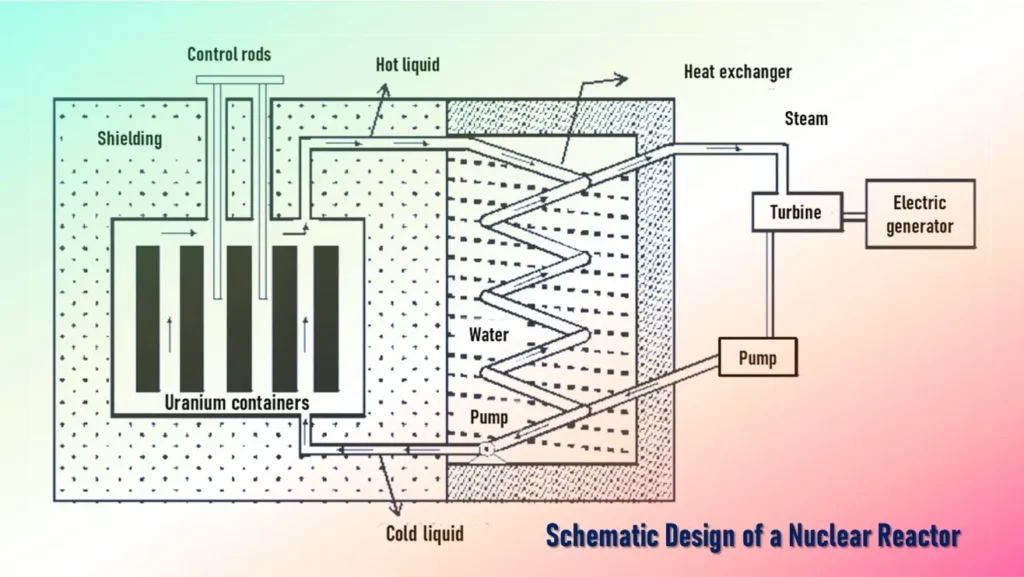A nuclear reactor is a device in which the nuclear fission reaction takes place in a self-sustained and controlled manner. The first nuclear reactor was built in 1942 at Chicago, USA.
Depending on the purpose for which the reactors are used, they may be classified into research reactors, production reactors and power reactors.
Research reactors are used primarily to supply neutrons for research purposes and for production of radio-isotopes. The purpose of production reactors is to convert fertile (non-fissile but abundant) material into fissile material.
The power reactor converts nuclear fission energy into electric power. The power reactors can be further classified into boiling water reactor, pressurized water reactor, pressurized heavy water reactor and fast breeder reactor depending upon the choice of the moderator and the coolant used.
Numerous reactors of different designs have been constructed all over the world for a variety of purposes, but there exists a number of general features common to all the reactors.
General features common to all the Nuclear Reactors
Fissile Material
The fissile material or nuclear fuel generally used is 92 U 235. But this exists only in a small amount (0.7%) in natural uranium.
Natural uranium is enriched with more 92 U 235(2 – 5%) and this low enriched uranium is used as fuel in some reactors. Other than 92 U 235, the fissile isotopes U 233 and Pu 239 are also used as fuel in some of the reactors.
In the pressurized heavy water reactors (PHWR) built in India, natural uranium oxide is used as fuel. Tiny pellets of uranium oxide are packed in thin tubes of zirconium alloy and sealed to form a fuel rod. Nineteen such rods are tied together to form a fuel bundle.
The reactor vessel which goes by the name ‘Calandria’ has about three hundred tubes passing through it. The fuel bundles are placed in these tubes. The part of the reactor vessel which contains the fuel rods is known as reactor core.
Moderator
The function of a moderator is to slow down fast neutrons produced in the fission process. Ordinary water and heavy water are the commonly used moderators.
A good moderator slows down neutrons by elastic collisions and it does not remove them by absorption. The moderator is present in the space between the fuel rods in a channel. Graphite is also used as a moderator in some countries.
In fast breeder reactors, the fission chain reaction is sustained by fast neutrons and hence no moderator is required.
Neutron source
A source of neutrons is required to initiate the fission chain reaction for the first time. A mixture of beryllium with plutonium or radium or polonium is commonly used as a source of neutrons.
Control Rods
The control rods are used to control the chain reaction. They are very good absorbers of neutrons. They take up neutrons without fissioning. Lowering them into the reactor core will slow down the reaction.
They are held on electromagnetic clamps so that if there is a dangerous increase in core temperature they can be dropped into the reactor and so shut down the chain reaction.
The commonly used control rods are made up of elements like boron or cadmium. By pushing them in or pulling out, the reaction rate can be controlled.
Cooling System
The cooling system removes the heat generated in the reactor core. Ordinary water, heavy water and liquid sodium are the commonly used coolants. A good coolant must possess a large specific heat capacity and high boiling point.
The coolant passes through the tubes containing the fuel bundle and carries the heat from the fuel rods to the steam generator through heat exchanger. The steam runs the turbines to produce electricity in power reactors.
The coolant and the moderator are the same in the PHWR and PWR. In fast breeder reactors, liquid sodium is used as the coolant. A high temperature is produced in the reactor core of the fast breeder reactors.
Sodium is solid at room temperature but liquefies at 98°C. It has a wide working temperature since it does not boil until 892°C.
That brackets the range of operating temperatures for the reactor so that it does not need to be pressurized as does a water-steam coolant system. It has a large specific heat so that it is an efficient heat-transfer fluid.
Neutron Reflectors
Neutron reflectors prevent the leakage of neutrons to a large extent, by reflecting them back. In pressurized heavy water reactors, the moderator itself acts as the reflector.
In the fast breeder reactors, the reactor core is surrounded by depleted uranium (uranium which contains less than 0.7% of 92 U235) or thorium (90Th232) which acts as a neutron reflector. Neutrons escaping from the reactor core convert these materials into Pu239 or U233 respectively.
Shielding
As a protection against the harmful radiations, the reactor is surrounded by a concrete wall of thickness about 2 to 2.5 m.
